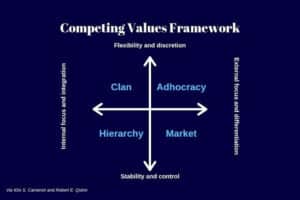“We are what we repeatedly do.” – Aristotle.
“It’s the personality of your company, and it plays a large part in your employees’ overall satisfaction.” (https://builtin.com/company-culture/types-of-organizational-culture)
On the surface, an organization’s “personality traits” at different times can be competitive, sleepy, energized, or even depressing, or sometimes genuinely “like a family”…
What underlies organizational culture and its changing dynamics are leadership, visions, shared values, beliefs, core principles, systems, assumptions, attitudes, habits, norms, language, brand symbols, business identity, environment, location, national culture, “the way we do things here,” or, in our TEP expert’s words, “the energy” of an organization… all of which make up the characteristics of organizational culture.
More than policies and mission statements, actions speak louder about a company’s culture: how leadership interacts with management and employees, how corporate initiatives are communicated and implemented — from top down or from motivated workforce engagement — how executives and management handle crisis situations, how the company reacts to changing markets, if a company prioritizes individual growth, purposefulness, and a learning environment over internal competitions for reaching sales goals, and so on.
The right organizational culture is paramount to the wellbeing and productivity of a company’s workforce, the overall health of a company, and its successful growth.
https://www.achievers.com/blog/organizational-culture-definition/ states that “culture is one of the main reasons that 65% of employees stay in their job… 77% of workers consider a company’s culture before applying…companies with a positive culture have up to 72% higher employee engagement rate.”
“Companies with healthy cultures are 1.5 times more likely to experience revenue growth of 15 percent or more over three years, and 2.5 times more likely to experience significant stock growth over the same period. Despite this, only 31 percent of HR leaders believe their organizations have the culture they need to drive future business, and getting there is no easy task — 85 percent of organizations fail in transforming their cultures.”
According to https://builtin.com/company-culture/types-of-organizational-culture and other sources, there are four basic types of organizational culture, as illustrated by the diagram and the descriptions below:

The above was developed by Robert E. Quinn and Kim S. Cameron of the University of Michigan, and is generally accepted and used by leaders.
Any of the four types are neither good nor bad, per se. An organization may have any or all of them at different stages of its growth.
In addition, other cultures and subcultures are common in organizations, such as learning culture, coaching culture, purpose culture, accountability culture, etc.
“The culture reflects how employees, customers, vendors, and stakeholders experience the organization and its brand.” (https://www.achievers.com/blog/organizational-culture-definition/)
Shared values, beliefs, and purposes are not only the foundation for a company culture, but also the foundation for brand identity. “Brand identity is forged by internal leadership, culture, and workforce, then validated in the marketplace, as customers vote with their dollars. What a company’s brand stands for ultimately becomes what truly connects with the end-users, consumers, customers, and clients,” said Joanne Z. Tan, brand strategist and branding expert at 10 Plus Brand.
For organizations that are shifting towards human centered culture and people strategies, perhaps the greatest challenge is culture change. It takes time, as well as deliberate, strategic, and persistent efforts, rather than simple determination on the part of leaders.
Microsoft, for example, used to foster competitiveness prior to its cultural transformation into a continuous learning culture for workforce improvement, by its CEO Satya Nadella. The long term benefit from this changed culture was Microsoft’s market cap of $1 trillion, making it one of the most valuable global companies, and of course, a happier place to work.
Many factors can positively influence organizational culture, such as aligning employees’ intrinsic talents and passions with their roles and functions at the workplace, communications based on transparency and authenticity, creating a growth environment for management and people at all levels, timely recognition of employees, mentorship of new leaders, etc.
Engaging outside expertise such as TEP.Global can help executives and HR professionals recognize their blind spots, gain perspective, and implement organizational culture changes in alignment with your mission, values, and goals.
© Dr. Vic all rights reserved.
TEP.Global not only has a combined 100 years of experience and expertise in people management, talent acquisition, executive assessment, but also deep knowledge in building teams and workplace culture in organizations of all sizes. For more information and insights, please contact us.
Leave a Reply